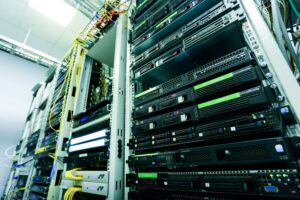Many companies use the Internet for their daily operations and need fast and reliable network connections for their employees to be productive. There are two main ways of supplying internet to an office; wirelessly or through cables.
Wireless connections (also known as WLAN) is a network technology that provides internet access to devices in range via radio waves. Click to learn the WLAN basics.
Wired connections are network connections that hardware devices receive mainly through ethernet cables. Both forms of internet access are widely used in offices worldwide, but which is better? The answer depends on these factors:
Mobility
A wireless local area network (WLAN) connects employees to the internet without physically connecting their devices to anything. This lets them move around their office freely and attend to business anywhere in the building. Ethernet cables do not provide this luxury, because any device accessing the internet through it has to be confined to a specific location.
Speed
Internet connection via ethernet cables tends to be faster and more stable than WLAN. WLAN can also be affected by interference, so companies that prioritize fast internet would benefit more from using ethernet cables.
Maintenance
Wired internet infrastructure is usually easier to maintain and more durable than that of WLAN. This makes them cost-effective and a better long-term investment for companies. Network connectivity issues via ethernet cables are also easier to troubleshoot than those on WLAN.
Installation cost
WLAN infrastructure (like Wi-Fi) costs less to install compared to wired connections. This is mainly because ethernet cables would only need to be connected to a company’s wireless access points, and not every device on the network. Wired networks on the other hand need ethernet cables for every work device.
Scalability
Wireless connections make it easier for a company to onboard new employees and add new devices to the network. All they need is the password to the router. Meanwhile, offices that use wired networks might need to order new ethernet cables whenever they want to scale.
Cybersecurity
Using the Internet for business operations has cybersecurity risks. Both types of network connections are not immune to cyberattacks, but WLAN is more at risk. This is because hackers can connect to a company’s wireless access points and intercept their data. Successful data interceptions can lead to data leaks, ransomware attacks, and DDoS business disruptions.
Which Is Better?
It is almost impossible to give a one-size-fits-all answer. WLAN and ethernet cable connections have their upsides and downsides as discussed above. The right type of network connection varies from business to business.
For example, an office can have thick walls that make it difficult for wireless internet signals to move in and out of the building. In that case, ethernet cables will be the better option. Meanwhile, another business will need their employees to move around a lot with phones and tablets while working, making WLAN the preferred option.
Endnote
Before choosing between WLAN and ethernet cables, business owners should assess their company’s needs and operating conditions to determine the right type of internet connection for their office. Both forms of internet connections are good and reliable but have their pros and cons. As a rule, companies that need internet high speed and stability should opt for ethernet cables, while those that prioritize employee mobility should use WLAN.


